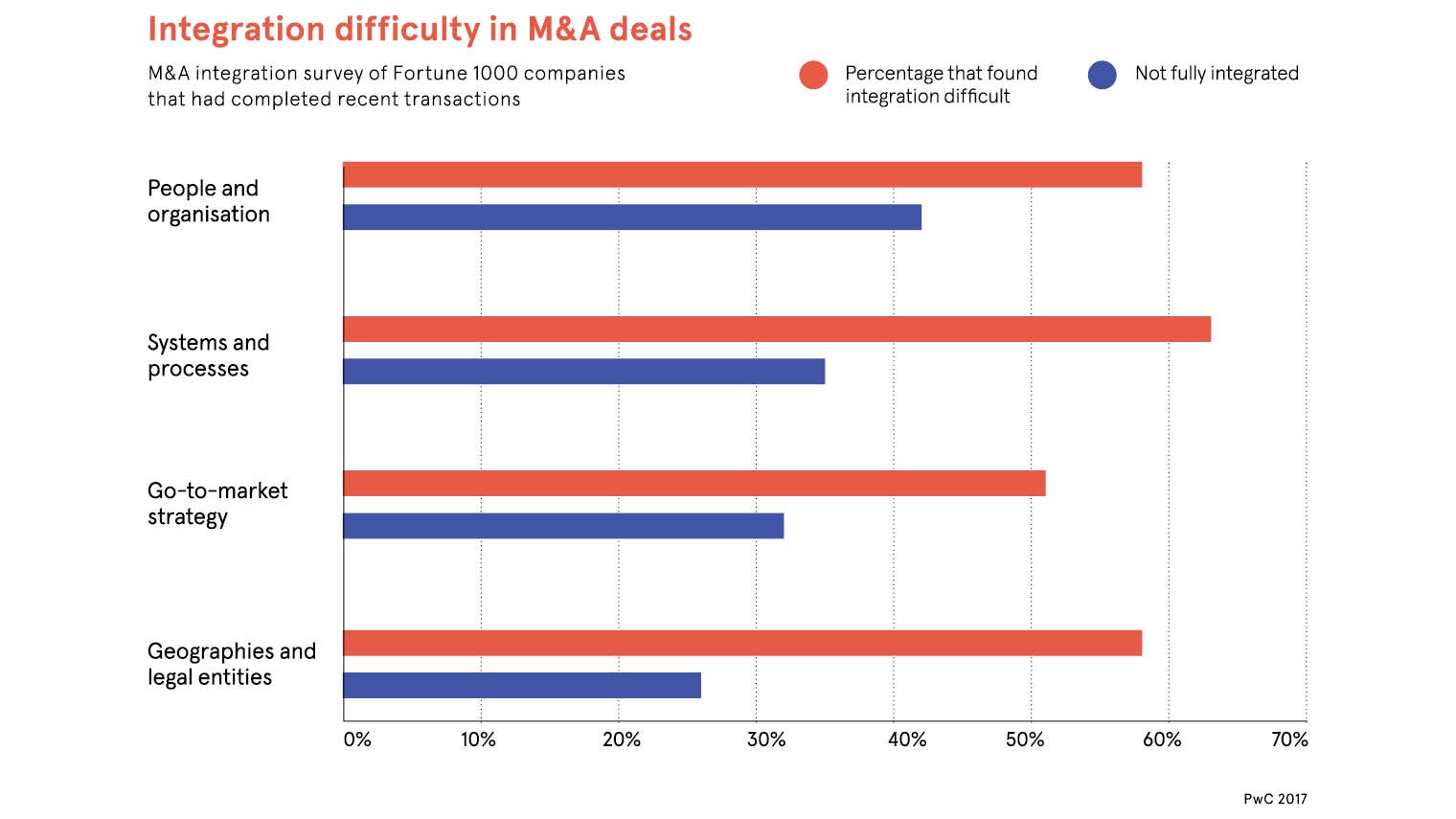Global mergers and acquisitions (M&A) activity hit new highs in the first half of 2018.
Latest data from Thomson Reuters Deal Intelligence indicates that the value of transactions rose by 64 per cent to $2.5 trillion in the first half of 2018 compared with the same period in 2017. In the strongest year-to-date period since records began in 1980, growth was driven by a relatively benign economic environment, readily available capital and cheap debt.
But despite corporate confidence also being high, particularly in the United States, the likelihood that any given merger or acquisition will succeed is low.
In fact, management consultancy KPMG’s latest biennial report on the issue reveals that only about a third of such transactions in North America add any value at all, while nearly 70 per cent actually reduce shareholder worth or, at best, are neutral.
Cultural issues the Achilles’ heel of mergers and acquisitions
Although this situation does not necessarily mean a fall in the overall value of the merged entities, it does mean that share price gains, while often positive, are less than might have been expected if the two companies had not combined.
Much of the problem though, says Daniel Domberger, partner and head of M&A advisory firm Livingstone Partner’s media and technology team, comes down to cultural issues.
Culture is consistently a very important factor in doing a deal and making it successful because people are people, and culture is simply an expression of those people within an organisation
“Culture is consistently a very important factor in doing a deal and making it successful because people are people, and culture is simply an expression of those people within an organisation,” he says. “It’s often viewed as ‘putting beanbags in the office’, but there’s a clear distinction between perks and culture, which is more about how people interact and get on.”
This means that even before a transaction takes place, it is crucial for organisations to undertake cultural, as well as the usual financial and legal, due diligence to understand whether they are compatible or not. Although according to Angelica Carr, director of mergers and acquisitions specialist Aim Business Coaching, as many as three out of five companies currently fail to do so.
Proper planning is essential for smooth cultural transition
Cultural due diligence involves understanding everything from values to operating styles and communication approaches, the aim being to identify what could break the deal.
Another vital component of the pre-planning stage, meanwhile, is to devise an authentic communications plan that is based on such insights and will come into force on the day the transaction goes through.
This plan should equip leaders with the appropriate tools, training and opportunities to clarify to employees what change will look like and the rationale behind it as quickly as possible to minimise fear, uncertainty and doubt. A further aim is for the senior management team to present a unified front while laying out a strong, positive vision for the future.
Katie Mahony, strategy planning director at management consultancy Lane4, explains: “It’s about helping people to understand what the new ‘normal’ is. So cultural values have to be defined, and leaders need to provide the cultural framework and future vision in such a way that people can buy into them and make them their own. And if they do, things will fly.”

Employee feelings on mergers and acquisitions must be listened to
But doing so also necessitates providing employees with a safe space to express their emotions, particularly in the case of restructuring and job losses. Therefore, ensuring leaders and managers make space for both formal and informal conversations plays an important role.
“People talk about communications and realise it should be a big line on their strategy document,” says Ms Mahony. “But the reality is that they rarely realise the importance of two-way communications, which is about ensuring people feel listened to and involved.”
Failure to get this right can have serious consequences though, not least in terms of employee engagement and retaining key talent. Staff losses tend to occur in two key peaks: very quickly after a transaction takes place and a few months later, if there is a lack of perceived progress.
But for those left behind, feelings of insecurity can have a huge impact on productivity. “People are OK dealing with change, but not with uncertainty and ambiguity,” says Ms Carr. “In fact, reports say that employees in a merger situation spend on average two hours a day worrying about its impact rather than doing any work.”
Integrating cultures key to successful mergers and acquisitions
Another key hurdle is failing to integrate corporate cultures effectively, which is a particularly difficult thing to do if they are very different to begin with. Such a situation can lead to culture clashes and the creation of a destructive “them and us” scenario, which again may translate into talent walking out the door, thereby diluting the value of the transaction.
As a result, it is important to help both sides understand what they want to hold on to, what is dear to them and what they are happy to leave behind.
It also means “allowing people to keep little things that matter to them, such as mascots, which may sound like kids’ stuff, but it makes them happy and helps them through the transition”, adds Ms Mahony.
Just as important though, following mergers and acquisitions, is to encourage people from different locations to get to know each other as real people and to celebrate success, no matter how modest. As Ms Carr concludes: “Even if it’s small, people ultimately just want to feel everything’s OK and is on the right path.”
Cultural issues the Achilles' heel of mergers and acquisitions
Proper planning is essential for smooth cultural transition

